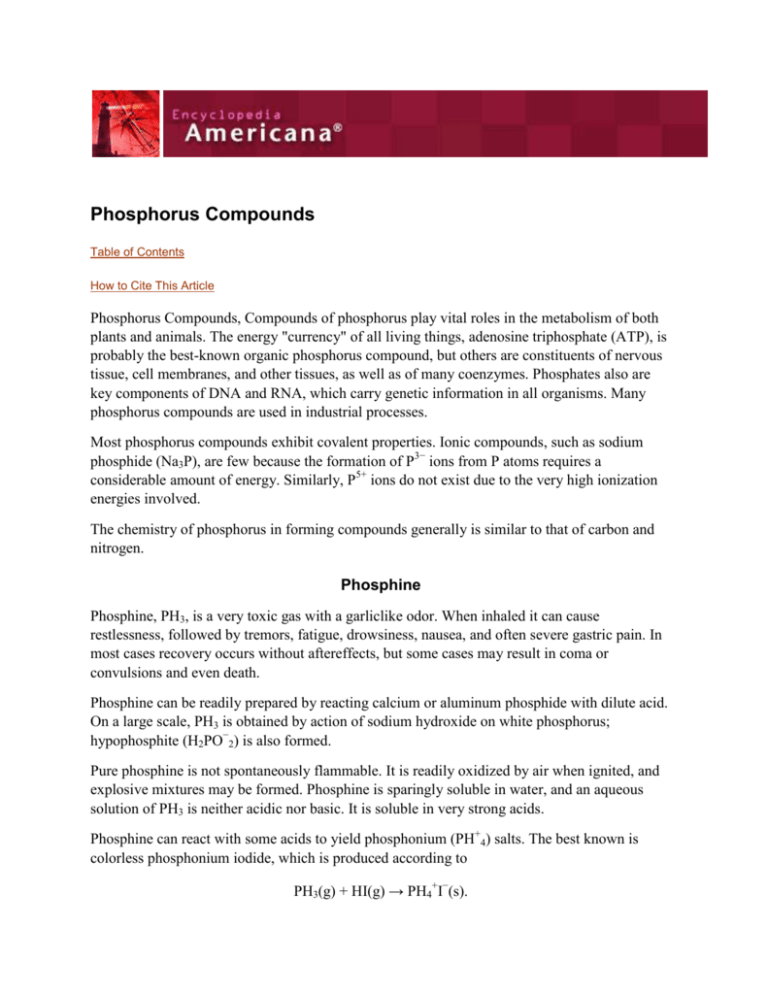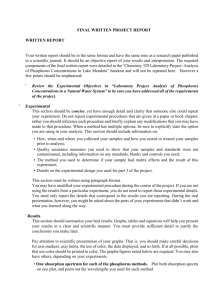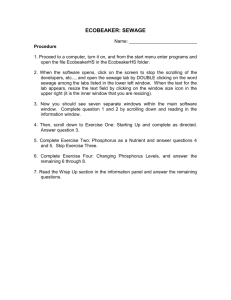
Phosphorus Compounds
Table of Contents
How to Cite This Article
Phosphorus Compounds, Compounds of phosphorus play vital roles in the metabolism of both
plants and animals. The energy "currency" of all living things, adenosine triphosphate (ATP), is
probably the best-known organic phosphorus compound, but others are constituents of nervous
tissue, cell membranes, and other tissues, as well as of many coenzymes. Phosphates also are
key components of DNA and RNA, which carry genetic information in all organisms. Many
phosphorus compounds are used in industrial processes.
Most phosphorus compounds exhibit covalent properties. Ionic compounds, such as sodium
phosphide (Na3P), are few because the formation of P3− ions from P atoms requires a
considerable amount of energy. Similarly, P5+ ions do not exist due to the very high ionization
energies involved.
The chemistry of phosphorus in forming compounds generally is similar to that of carbon and
nitrogen.
Phosphine
Phosphine, PH3, is a very toxic gas with a garliclike odor. When inhaled it can cause
restlessness, followed by tremors, fatigue, drowsiness, nausea, and often severe gastric pain. In
most cases recovery occurs without aftereffects, but some cases may result in coma or
convulsions and even death.
Phosphine can be readily prepared by reacting calcium or aluminum phosphide with dilute acid.
On a large scale, PH3 is obtained by action of sodium hydroxide on white phosphorus;
hypophosphite (H2PO−2) is also formed.
Pure phosphine is not spontaneously flammable. It is readily oxidized by air when ignited, and
explosive mixtures may be formed. Phosphine is sparingly soluble in water, and an aqueous
solution of PH3 is neither acidic nor basic. It is soluble in very strong acids.
Phosphine can react with some acids to yield phosphonium (PH+4) salts. The best known is
colorless phosphonium iodide, which is produced according to
PH3(g) + HI(g) → PH4+I−(s).
Other hydrides of phosphorus also exist. Diphosphine (P2H4) is spontaneously flammable and
decomposes on storage.
Halides
Phosphorus halides with the formulas PX3, PX5, and P2X4 generally can be formed by direct
reaction of the elements.
Phosphorus trifluoride (PF3) is a colorless, highly poisonous gas. It can best be prepared by
fluorinating PCl3. The trifluoride is slowly hydrolyzed by water and is attacked by alkalies.
Phosphorus trichloride reacts readily with oxygen to form POCl3. It also is violently hydrolyzed
by water to yield phosphorous acid.
Phosphorus pentafluoride (PF5) is obtained by the interaction of PCl5 with CaF2 at temperatures
above 300 °C (570 °F). It is a very strong Lewis acid and is a good catalyst for ionic
polymerization.
In the solid phase, phosphorus(V) chloride actually exists as the ionic compound [PCl4]+
[PCl6]−. Solid phosphorus(V) bromide is also ionic, existing as [PBr4]+Br−.
Oxides
There are five main phosphorus oxides: P4O6, P4O7, P4O8, P4O9, and P4O10. Both phosphorus
trioxide (P4O6) and phosphorus pentoxide (P4O10) derived their names from their empirical
formulas—P2O3 and P2O5, respectively.
When elemental phosphorus, P4, is burned in an oxygen-rich environment, P4O10 is obtained. It
is a white crystalline solid that sublimes at 1 atmosphere of pressure at 360 °C (680 °F). Its
volatility provides a good method of purifying it from other nonvolatile impurities. One of the
most interesting properties of P4O10 is that it is one of the best drying agents known, as it has a
great affinity for water. This oxide even extracts water from many other dehydrating agents.
The oxide P4O6 is obtained when elemental phosphorus is burned in an oxygen-poor
environment. This oxide is a colorless, volatile compound with a low melting point (23.8 °C, or
74.8 °F). Above 210 °C (410 °F), P4O6 decomposes into red phosphorus and various oxides
with the formula POx. A vigorous reaction occurs when it is mixed with Cl2 or Br2. However, it
is not attacked by oxygen gas at room temperature.
Acids and Salts
A phosphorus oxyacid contains at least one P-OH group with an ionizable hydrogen atom. The
hydrogen atom in a P-H group is not acidic.
Orthophosphoric acid (H3PO4), which contains three acidic hydrogen atoms, is commonly
called phosphoric acid. It is one of the oldest known and most important of the phosphorus
compounds. See also Phosphoric Acid.
Hypophosphorous acid has the general formula H3PO2, which is best written as H(H2PO2),
indicating that it has one acidic hydrogen atom. It can be prepared by reacting the calcium salt
with sulfuric acid. The acid and its salts are used as reducing agents.
Phosphorous acid, H3PO3 or H2(HPO3), has two acidic hydrogens. The acid can be obtained by
reacting P4O6 with water. When pure, it is a deliquescent colorless solid. Both the acid and its
anion, phosphite (HPO32−), are strong reducing agents.
Other acids, such as hypophosphoric (H4P2O6), pyrophosphorous (H4P2O5), and
metaphosphorous (HPO2), can also be prepared.
Phosphate salts are extremely important in food processing. The reaction of alkali metals with
orthophosphoric acid leads to a series of orthophosphate salts with pH values of 4.0 (moderately
acid), 8.3 (moderately alkaline), and 12.0 (strongly alkaline). The wide pH range of these salts
is useful in adjusting the pH of foods and chemical systems.
Pyrophosphates, which contain two or more P atoms per molecule, are obtained by heating
orthophosphates. The polyphosphates have dispersing or emulsifying properties. They are used
for controlling oxidative rancidity and undesired color formation in foods. Sodium acid
pyrophosphate (SAPP), which contains two P atoms, is used as a leavening acid in baking.
Sodium tripolyphosphate (STPP), which contains three P atoms, reacts with the protein in meat
and fish to prevent denaturing or loss of fluids.
Organic
Organophosphorus compounds have many important industrial uses. They are used as
plasticizers, gasoline additives, and flotation agents; in insecticides; and in synthesizing organic
compounds. In nature these compounds are required for fermentation, photosynthesis, muscle
activity, and in the nucleotides.
Zvi C. Kornblum
The Cooper Union
Top of Page
How to cite this article:
MLA (Modern Language Association) style:
Kornblum, Zvi C. "Phosphorus Compounds." Encyclopedia Americana. 2010. Grolier Online.
24 July. 2010 <http://ea.grolier.com/article?id=0311710-00>.
Chicago Manual of Style:
Kornblum, Zvi C. "Phosphorus Compounds." Encyclopedia Americana. Grolier Online
http://ea.grolier.com/article?id=0311710-00 (accessed July 24, 2010).
APA (American Psychological Association) style:
Kornblum, Z. C. (2010). Phosphorus Compounds. Encyclopedia Americana. Retrieved July 24,
2010, from Grolier Online http://ea.grolier.com/article?id=0311710-00
Home | Help | About
™ & © 2010 Scholastic Inc. All Rights Reserved.






